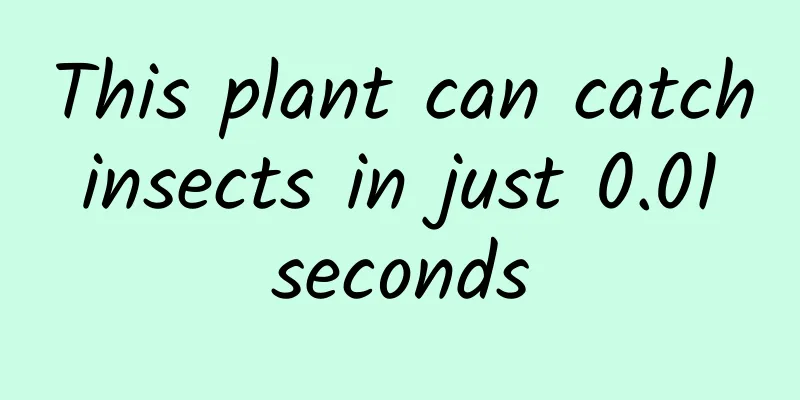This plant can catch insects in just 0.01 seconds

|
What is the biggest difference between plants and animals? I believe most people's answer is: animals can move, but plants can't. Indeed, in nature, most plants quietly guard their own space, and won't move for a day or two, a year or two, or even their entire lives. But you may not know that the fastest-reacting creature is not an animal, but a plant. They can capture prey in a flash. The protagonist of this article, the raccoon algae, is a plant with this magical ability. Part 1 "Picky" endangered plants Although the word "algae" is in its name, the raccoon algae is not an algae plant, but a flowering and fruiting angiosperm. It belongs to the same large family of Drosera as Drosera and Venus flytrap. Scientists have discovered 19 species of raccoon algae in fossils, but there is only one species left in the genus raccoon algae, which further highlights its rarity. Raccoon algae hunting prey Although raccoon algae are distributed in Europe, Asia, Africa and Australia, the population of raccoon algae is extremely small in each habitat, so it is listed in the "Red List of the World Conservation Union" as an endangered plant. The reason why raccoon algae is endangered is inseparable from its unique lifestyle. As a carnivorous plant, raccoon algae is very "picky" about its habitat. They like to grow in shallow water areas with a depth of 1.7 to 2 meters. They not only need sufficient sunlight, but also require that the nutrient content in the water must be maintained at a low level, and the pH value of the water environment must be maintained at around 6. Such stringent requirements greatly limit the reproduction rate of raccoon algae. Because it likes a clean water environment, the nutrients that raccoon algae obtains from the water are very limited, so it can only "stand on its own feet" and supplement its nutrition by catching prey. Part 2 Aquatic "hunter" with its own trap When it comes to aquatic carnivorous plants, you may first think of Bladderwort, after all, it is a huge family consisting of 233 species, and Bladderwort is much more common than Raccoon Algae. Therefore, many people confuse Raccoon Algae with Bladderwort, thinking that their appearance and hunting "devices" are similar, which is actually a huge misunderstanding. The insect-catching structure of bladderwort is not obvious, and its insect-catching capsule is usually underwater. The insect-catching capsule is a "trap" that can only enter but not exit. When small animals such as water fleas touch the receptors of the insect-catching capsule, the insect-catching capsule will suddenly open and suck the prey into the insect-catching capsule like a vacuum cleaner. This process takes only 0.01 seconds at the fastest. The insect-catching structure of the raccoon algae is much more obvious, like a miniature version of the Venus flytrap, with a small clamp formed by specialized leaves quietly waiting for prey to take the bait. Once the prey touches the sensory cilia on it, the insect-catching clamp will close instantly, taking about 0.01 seconds. Then, the prey will be slowly digested and absorbed by the raccoon algae. Part 3 Survival rules of carnivorous plants We all know that the way plants obtain energy and main nutrients is photosynthesis - in chloroplasts, they use carbon dioxide and water as raw materials and the energy of sunlight to produce glucose and a series of organic substances. In theory, plants can fill their stomachs with water, sunlight and air. However, when plants produce proteins, nucleic acids and build their own cell "walls", they need to use some special nutrients. For example, nitrogen is a key element in amino acids, and phosphorus is a key component of cell membranes. There are a lot of nitrogen and phosphorus in the soil. In most cases, plants absorb these nutrients from the soil through their roots. Some plants take a different approach and simply "eat" insect excrement to obtain nutrients. This is the case with a plant called the saw-toothed flycatcher distributed in South Africa. Instead of eating the captured prey directly, they use the prey to "entertain" an insect called an assassin bug. The assassin bug does not "eat for free" either, but "gives back" to the saw-toothed flycatcher with its excrement. After the assassin bug digests and decomposes the food, the saw-toothed flycatcher can more easily absorb the nitrogen in it. Although carnivorous plants have conquered many special living environments with their superb hunting skills, they are also more vulnerable to external disturbances. Human activities have destroyed the living environments such as wetlands, cliffs, and rainforests on which carnivorous plants depend for survival. These seemingly ferocious and powerful carnivorous plants will appear helpless and weak after losing their habitats. Protecting the habitats of carnivorous plants and not collecting wild carnivorous plants at will, so that these magical plants can show their talents in their own homes, is what everyone who loves nature should do. |
>>: Who said that if you get a haircut in the first month of the lunar year, your uncle will die?
Recommend
iOS 14.5 is available first! 217 new emojis added, green screen issue fixed
Apple's iOS system is very comfortable to use...
Who "killed" Luo Yonghao?
A friend said he wanted to buy a ticket to attend...
How much does it cost to be an agent for a homestay mini program in Hengshui?
Why should you be an agent for WeChat Mini Progra...
FAW Audi dealers jointly oppose Audi's joint venture with SAIC Volkswagen
Audi's plan to form a joint venture with SAIC...
Collection | 7 secrets to using "Toutiao" to attract traffic. It will be too late if you don't do it now!
There are many self-media platforms today, and al...
After reading Martin Whitman, I realized I was stupid.
Like "Securities Analysis", this is a b...
Quantitative Science Lecture Hall - Jiang Linghai's compulsory course on returning to zero and starting a journey, call auction + time-sharing market
Quantitative Science Lecture Hall - Jiang Linghai...
Nokia and Alcatel-Lucent's marriage has transformed them from a two-horse race to a three-horse race
Yesterday was a good day for "marriage"...
Super recommendation detonates the homepage, leveraging the homepage's average monthly traffic of 1 million to continuously grow (full practical operation) 7 days fast low-cost new users
Jiucai e-commerce · Lao Tao will help you easily ...
Why do operators launch their own brand of mobile phones?
Recently, China Telecom released the Tianyi No. 1...
This is not just playing house, wooden satellites can also fly into space!
Popular Science Times reporter Chen Jie This is n...
How to optimize Weibo advertising creativity?
Marketing status: The advertiser is a local O2O d...
WeChat input method is under development Zhang Xiaolong: We will never analyze user chat records
On January 19, with the theme of "Inspiring ...
Is the mosquito repellent song that is popular on the Internet really effective?
Summer is here, and it’s time to “fight mosquitoe...
How much does it cost to make a musical instrument mini program in Xilingol League?
The main factors affecting the price of mini prog...









